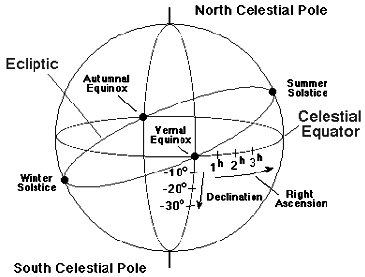|
|
| STAR MAPS |
|
Right Ascension and Declination In the celestial coordinate system the North and
South Celestial Poles are determined by projecting the rotation axis of
the Earth to intersect the celestial sphere, which in turn defines a
Celestial Equator. The celestial equivalent of latitude is called
declination and is measured in degrees North (positive numbers) or South
(negative numbers) of the Equinoxes and Solstices The zero point for celestial longitude (that is, for right ascension) is the Vernal Equinox, which is that intersection of the ecliptic and the celestial equator near where the Sun is located in the Northern Hemisphere Spring. The other intersection of the Celestial Equator and the Ecliptic is termed the Autumnal Equinox. When the Sun is at one of the equinoxes the lengths of day and night are equivalent (equinox derives from a root meaning "equal night"). The time of the Vernal Equinox is typically about March 21 and ofthe Autumnal Equinox about September 22. The point on the ecliptic where the Sun is most north of the celestial equator is termed the Summer Solstice and the point where it is most south of the celestial equator is termed the Winter Solstice. In the Northern Hemisphere the hours of daylight are longest when the Sun is near the Summer Solstice (around June 22) and shortest when the Sun is near the Winter Solstice (around December 22). The opposite is true in the Southern Hemisphere. The term solstice means to "stand still"; at the solstices the Sun reaches its most northern or most southern position in the sky and begins to move back toward the celestial equator. Thus, it "stands still" with respect to its apparent North-South drift on the celestial sphere at that time. Traditionally, Northern Hemisphere Spring and Fall begin at the times of the corresponding equinoxes, while Northern Hemisphere Winter and Summer begin at the corresponding solstices. In the Southern Hemisphere, the seasons are reversed Coordinates on the Celestial Sphere The right ascension (R.A.) and declination (dec) of an object on the celestial sphere specify its position uniquely, just as the latitude and longitude of an object on the Earth's surface define a unique location. Thus, for example, the star Sirius has celestial coordinates 6 hr 45 min R.A. and -16 degrees 43 minutes declination
Keeping your Perspective Do not become confused because the perspectives in
the celestial sphere diagram (top) and the sky segment diagram containing
Sirius are different. In the celestial sphere diagram one is imagining an
outside view of the celestial sphere . In the diagram above showing
the position of Sirius in the sky the view is instead the actual sky as
viewed from the Earth (that is, from the center of the sphere in the first
diagram). ON ALL 68 MAPS PROVIDED
|

